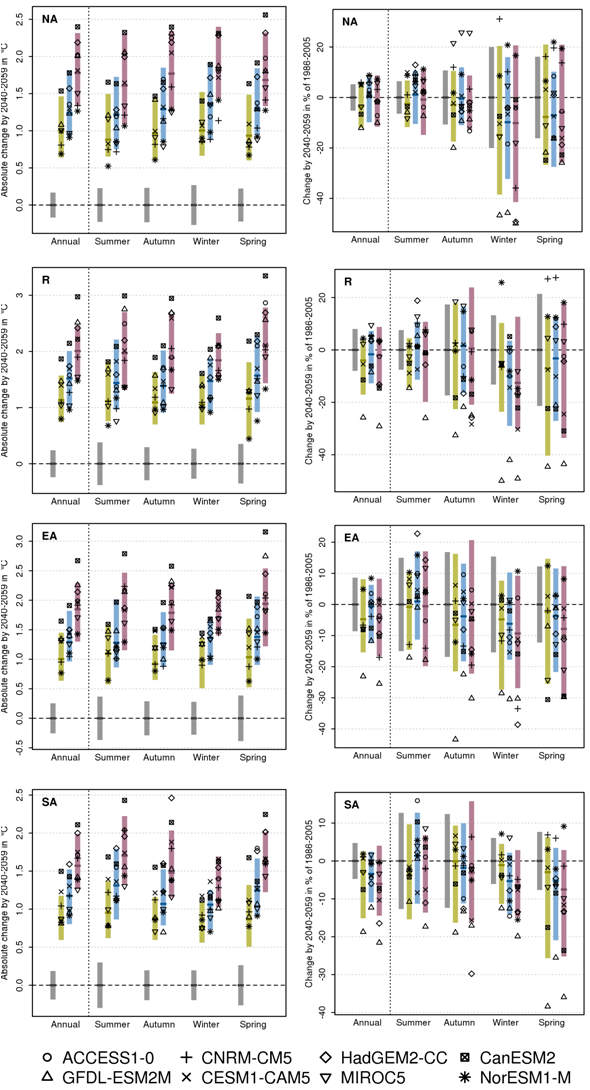Climate Change in Australia
Climate information, projections, tools and data
Eight-MODEL sub-set FOR APPLICATION-READY DATA
Eight of the 40 CMIP5 models assessed in this project have been selected for use in provision of application-ready data. This facilitates efficient exploration of climate projections for Australia.
Model selection
A number of steps were considered in the model selection process:
- Rejection of models that were found to have a low performance ranking across a number of metrics in Chapter 5 and in some other relevant assessments (see Chapter 9 of the Technical Report for a full description).
- Selection of models for which projection data were available for climate variables commonly used in impact assessments, for at least RCP4.5 and RCP8.5. Projections for other RCPs are included where possible.
- Amongst these, identification of models that are representative of the range of seasonal temperature and rainfall projections for a climate centred on 2050 and 2090 and RCP4.5 and RCP8.5 using the Australian Climate Futures software.
- Projections for wind were assessed separately from temperature and rainfall to ensure the CMIP5 range was captured. This is because the direction and magnitude of wind projections are not necessarily correlated with the temperature and/or rainfall projections.
- Availability of corresponding statistical or dynamical downscaled data.
- Consideration of the independence of the models (see Knutti 2013)
Selected CMIP5 models and reasons for their inclusion
| SELECTED MODELS | CLIMATE FUTURES | WIND | OTHER |
|---|---|---|---|
| ACCESS1.0 | Maximum consensus for many regions. | The model exhibited a high skill score with regard to historical climate. | |
| CESM1-CAM5 | Hotter and wetter, or hotter and least drying | This model was representative of a low change in an index of the Southern Annular Mode (per degree global warming). Further, the model has results representing all RCPs. | |
| CNRM-CM5 | Hot /wet end of range in Southern Australia | This model was representative of low warming/dry SST modes as described in Watterson (2012) (see Section 3.6). It also has a good representation of extreme El Niño in CMIP5 evaluations (see Cai et al., 2014). | |
| GFDL-ESM2M | Hotter and drier model for many clusters | Greatest increase | This model was representative of the hot/dry SST mode as described in Watterson (2012) (see Section 3.6). It also has a good representation of extreme El Niño in CMIP5 evaluations (see Cai et al., 2014). Further, the model has results representing all RCPs. |
| HadGEM2-CC | Maximum consensus for many regions. | Greatest reduction | This model has good representation of extreme El Niño in CMIP5 evaluations (see Cai et al., 2014) |
| CanESM2 | This model was representative of the hot/wet SST mode as described in Watterson ( 2012) (Section 3.6). It also has a high skill score with regard to historical climate and it increased representation of the spread in genealogy of models (Knutti et al., 2013). It also has good representation of extreme El Niño in CMIP5 evaluations (Cai et al., 2014). | ||
| MIROC5 | Low warming wetter model | This model was representative of a higher change in an index of the Southern Annular mode (per degree global warming). It also has good representation of extreme El Niño in CMIP5 evaluations (see Cai et al., 2014). Further, the model has results representing all RCPs. | |
| NorESM1-M | Low warming wettest representative model | No wind data | This model was representative of the low warming/wet SST mode as described in Watterson (2012) (see Section 3.6). The model also has results representing all RCPs. |
This table can be found in Box 9.2 of the Technical Report
Model Details
| MODEL | INSTITUTE | OCEAN RESOLUTION (°) | ATMOSPHERE RESOLUTION (°) [km at Equator] |
|---|---|---|---|
| ACCESS1.0 | CSIRO-BOM, Australia | 1.0×1.0 | 1.9×1.2 [210×130] |
| CanESM2 | CCCMA, Canada | 1.4×0.9 | 2.8×2.8 [310×310] |
| CESM1-CAM5 | NSF-DOE-NCAR, USA | 1.1×0.6 | 1.2×0. [130×100] |
| CNRM-CM5 | CNRM-CERFACS, France | 1.0×0.8 | 1.4×1.4 [155×155] |
| GFDL-ESM2M | NOAA, GFDL, USA | 1.0×1.0 | 2.5×2.0 [275×220] |
| HadGEM2-CC | MOHC, UK | 1.0×1.0 | 1.9×1.2 [210×130] |
| MIROC5 (for non-commercial use only) | JAMSTEC, Japan | 1.6×1.4 | 1.4×1.4 [155×155] |
| NorESM1-M | NCC, Norway | 1.1×0.6 | 2.5×1.9 [275×210] |
This information is extracted from Table 3.3.1 of the Technical Report
How well does the eight-model subset represent the range of projected changes from all models?
The bar plots in the expandable sections below, show where each model from the eight-model subset sits in relation to the range from all available models. For this analysis, average changes in temperature and rainfall over the four Super-Clusters were considered.
The plots show that the eight-model subset does a good job of representing the range in most cases. However, any form of sub-setting involves compromises and there are some situations where the subset under-represents the full range. In general, representation is better for temperature than rainfall, with the subset occasionally under-representing the cooler part of the range (e.g. 2050s Southern Australia, summer under RCP8.5). For rainfall, the subset sometimes under-represents the wetter part of the range (e.g. 2090s Eastern Australia, autumn under RCP4.5) and sometimes under-represents the drier part of the range (e.g. 2050s Northern Australia, spring under RCP4.5)
Mid Century (2050s)

Mid century (2050) projected temperature change in °C (left), rainfall relative percent change (right) for, from top to bottom, Northern Australia, Rangelands, Eastern Australia, and Southern Australia Super-Clusters. Data for annual, summer (DJF), autumn (MAM), winter (JJA) and spring (SON) are plotted from left to right in each graph. Bar ranges indicate 10th to 90th percentile of 20-year running mean of 40 CMIP5 models.
Late Century (2090s)

Late century (2090) projected temperature change in °C (left), rainfall relative percent change (right) for, from top to bottom, Northern Australia, Rangelands, Eastern Australia, and Southern Australia Super-Clusters. Data for annual, summer (DJF), autumn (MAM), winter (JJA) and spring (SON) are plotted from left to right in each graph. Bar ranges indicate 10th to 90th percentile of 20-year running mean of 40 CMIP5 models.
Page last updated 12th May 2021


